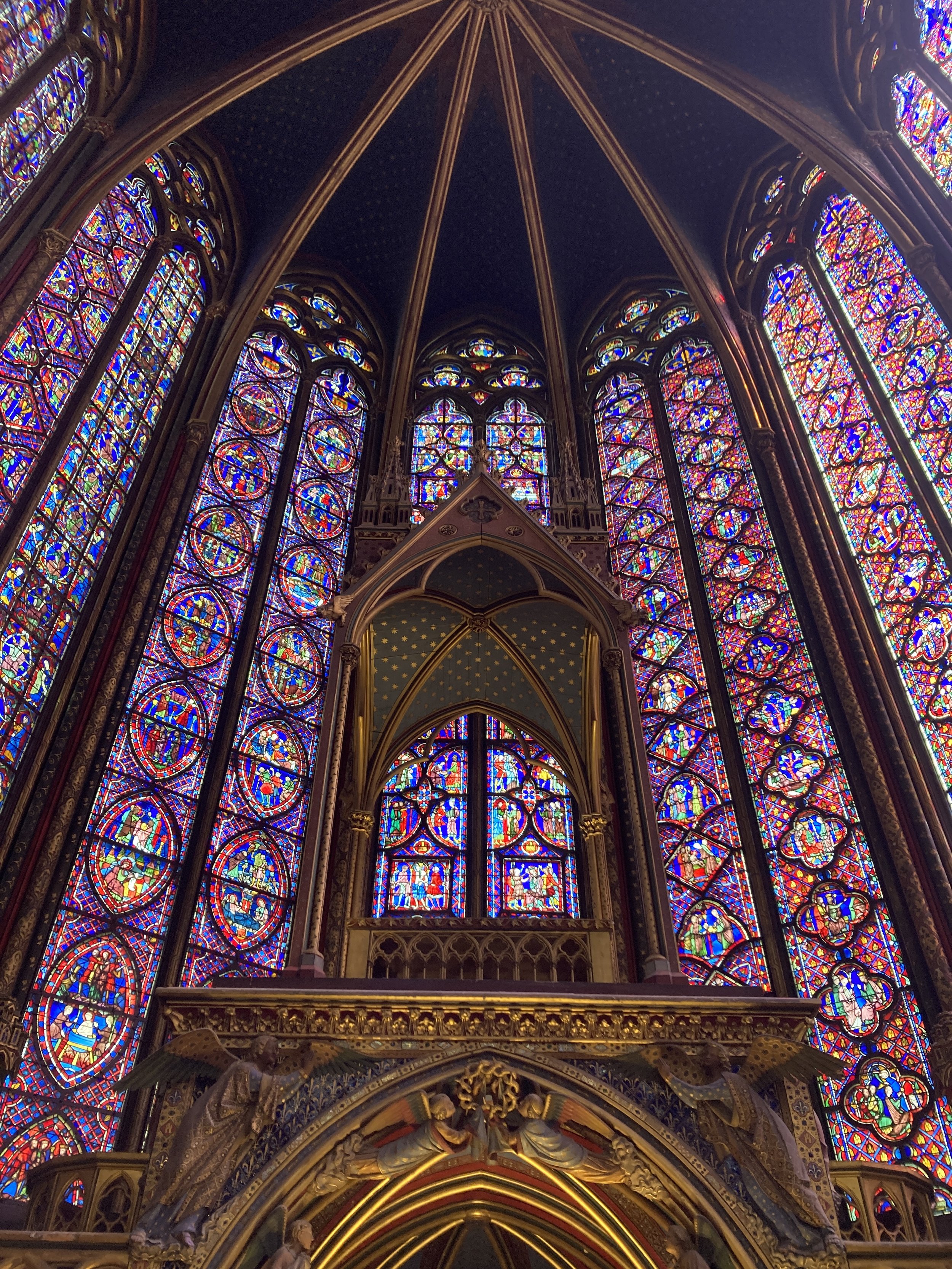This trip has been more formative and experiential than I could have ever imagined: I truly did not anticipate learning so much not only about literature and these cities, but also about life, and the ways in which I would like to live it.I have gained so much knowledge about myself, and have realized that, at some point in my life, I would love to live in both London and Paris. I love both of these cities so much now, and I am so excited to try and learn some French so I can be prepared the next time I find myself here. I was thinking about what to do for my last blog, and I thought of the idea to make a bookpacking alphabet: each letter with something(s) from bookpacking or the books or my personal adventures in London and Paris. Here it is!
Stained glass in the Eglise Saint-Severin
A is for
Asking for things in French when I know that I won’t be able to understand their answer
Avenue des Gobelins, next to the Gorbeau tenement.
B is for
Barricade, of course
Baron Hausmann and his big boulevards
Brick Lane and the Bangladeshi community
C is for
Cosette and Lucie, the paragons of purity and light as written by their respective male authors. They are too young to be married, according to me, and too blonde for a personality, according to Dickens and Hugo.
D is for
Darkness into Light: Thenardier “rescuing” Jean Valjean rescuing Marius in the sewer, Jean Valjean revealing his identity in court, Javert taking his life
E is for
Eros and Psyche embracing in the Louvre with such love and devotion as if they aren’t being stared at by tourists from across the world; very French of them.
F is for
Fortnum and Masons tea parlor and luxury foods
70 famines in India in 200 years of British colonialism
G is for
The Gherkin…
H is for
Hotel de Ville, where executions used to take place and the blood spilled and lives taken can be felt in the ground
I is for
Intimacy, where the French seem to thrive and their reputations precede them
Les Invalides, Napoleon Bonaparte’s massive mausoleum where his massive tomb sits in a crypt beneath a sunny fresco. He has a great view, but I can’t seem to think he is very happy in his death; the tomb itself conjures images of being pressed to death.
J is for
Jarvis Lorry, up in Temple Bar, scribbling away at some financial report with heads staked outside his window
Jarvis Lorry, in St-Germain-de-Pres, watching the Parisian mob sharpen their bloody instruments of death covered in rags and odd clothes, equally bloodied.
K is for
King Louis XIV and his Palace of Versailles, King Louis XVII and his Palace of the Tuileries, the Reign of Terror, and the return to the monarchy after it all.
L is for
Lightness into Dark: Fantine’s descent into poverty, watching Marius choose to join Enjolras on the barricade, _____
Liberty Leading the People, at the risk of being trite.
M is for
Musée De L’Orangerie: every piece of art I have ever made, I am convinced, is inspired by Monet’s Water lilies. Ever since the first time I saw these paintings in a book or magazine when I was a child, I think that they have lived in my mind and informed every color, brushstroke, line, and word in everything I’ve ever created.
N is for
Nighttime: the ways in which a city changes when the sun goes down
O is for
Opulence, and all its manifestations: in Buckingham Palace, in Versailles, in tea parlors, in luxury brand department stores. Ostentatious displays in 1789 and in 2023
The Opera; if I were a phantom, I would haunt this place too.
Old money
P is for
Peter Pan-funded Great Ormond Street Children's Hospital
Perseverance, as was needed on some of the longer, hotter, colder, or rainier afternoon excursions
Q is for
Quaint streets in both Paris and London, with old stone facades, trailing ivy, adorable awnings, cobblestone paths, old books, and signs whose origins span centuries.
R is for
Russell Square station, right by our London accommodations, and Russell Square Gardens, which we walked through to get to the station.
S is for
Stained glass
Sainte Chapelle
Saint Germain
Saint Antoine
Saint Severin
Saint Sulpice
Snow, John
T is for
Tavistock Square and Virginia Woolf’s bust, aghast
U is for
Underground: the trains, the sewers, the crypts, the Catacombs
V is for
Victor Hugo’s crypt in the Pantheon or Victor Hugo’s house or Victor Hugo Avenue
Vidya takes on London and Paris, alternatively
W is for
West End’s Sondheim theater and leaning over the row in front of us to see Les Miserables on stage
Westminster Abbey and the poets corner; did any of those people really want to be buried there?
X is for
Xenophobia: I’m thinking about the ways in which Paris and France have cemented themselves as places for refugees and immigrants from across the world to go to, but yet is one of the most anti-immigrant places in the world. After going to the mosque, the idea of Frenchness as the primary identity was a little terrifying.
Y is for
Ye Olde Cheshire Cheese, where Charles Dickens ate his meals and I had fish and chips for the first time; I’m still not sure how to feel about it.
Z is for
zed















